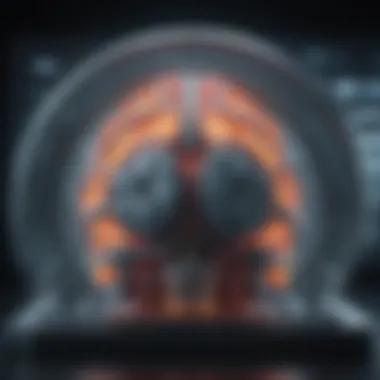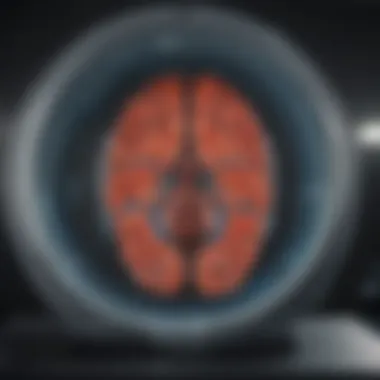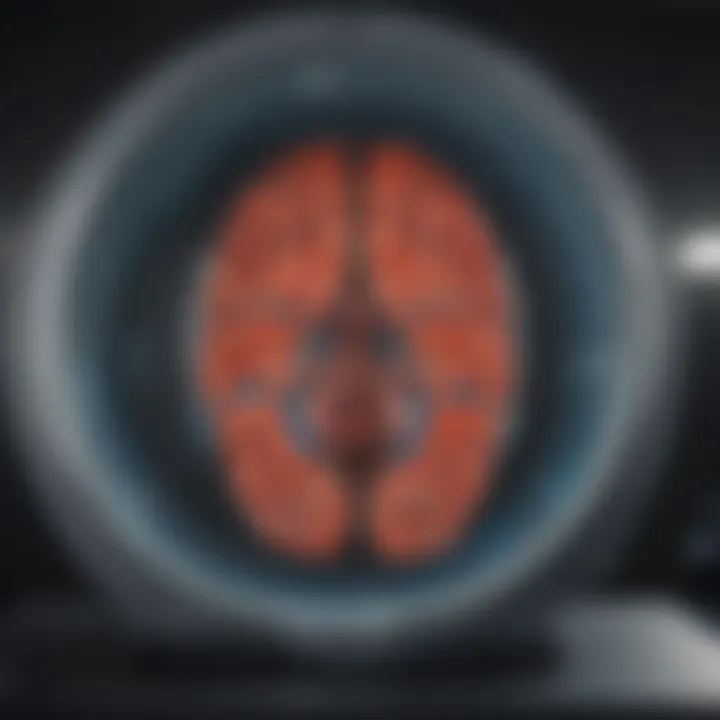Comprehensive Insights into 3D MRI Scans and Their Applications


Intro
3D MRI scans have become a focal point in medical imaging, offering enhanced visualization of internal structures. This technology transcends traditional two-dimensional imaging, enabling healthcare professionals to diagnose and treat conditions more effectively. The comprehensive examination of 3D MRI scans reveals their multifaceted applications, from neuroimaging to orthopedic assessments, and underscores their significance in modern medicine.
Understanding this technology requires a look into its foundational principles, operational methods, and areas where it excels or faces limitations. As the field of medical imaging evolves, so too does the promise of 3D MRI to improve patient outcomes and drive research forward.
Foreword to 3D MRI Scans
The realm of medical imaging has evolved significantly, with 3D MRI scans standing at the forefront of this transformation. Understanding 3D MRI scans is essential for healthcare providers, medical researchers, and educators. This article aims to provide thorough insights into this advanced imaging technique, emphasizing its importance, applications, and implications in various medical domains.
3D MRI scans employ a sophisticated imaging method that allows for detailed visualization of internal organs and structures. This technique turns MRI images into three-dimensional representations, enhancing the capability to detect abnormalities more effectively than traditional two-dimensional images.
Various aspects underline the relevance of 3D MRI technology:
- Precision: The shift from 2D to 3D imaging offers enhanced detail and accuracy, improving diagnosis.
- Non-invasive nature: 3D MRI scans do not involve harmful radiation, making them safer for patients.
- Diverse applications: From neurological imaging to evaluating tumors, the uses of 3D MRI are vast and significant in clinical practice.
- Technological evolution: Continuous advancements in MRI technology provide opportunities for future innovations that could further enhance imaging accuracy and patient care.
The subsequent sections will delve deeper into the definition, historical context, and the technical foundations of 3D MRI scans, providing a comprehensive backdrop against which readers can appreciate the current technological landscape and its future trajectory.
Definition and Overview
3D MRI stands for three-dimensional magnetic resonance imaging. This technology uses a powerful magnetic field, radio waves, and a computer to produce detailed images of organs and tissues within the body. Unlike traditional MRI, which generates two-dimensional slices, 3D MRI reconstructs images to create volumetric representations that reveal depth and structure.
An essential feature of 3D MRI is its ability to visualize soft tissues more clearly, making it an invaluable tool in the diagnosis and treatment planning across various fields of medicine. By combining data from multiple angles, it allows clinicians to examine areas in ways previously not possible.
Historical Context of MRI Technology
The history of MRI technology can be traced back to innovations in the late 20th century. The initial development began in the 1970s when the principles of nuclear magnetic resonance were adapted for medical use. The first human MRI scan occurred in 1977, marking a revolutionary step in medical imaging.
As years passed, improvements were made in hardware and software, leading to the introduction of 3D imaging capabilities in the 1990s. This development harnessed faster computers and advanced processing techniques, allowing for real-time imaging and better resolution.
This advancement paved the way for the widespread adoption of 3D MRI in clinical settings. Over the years, continuing research has focused on optimizing the technology further, enhancing speed, accuracy, and overall image quality. Today, 3D MRI scans are a standard component of diagnostic imaging protocols, particularly in complex cases requiring detailed examinations.
Technical Foundations of 3D MRI Scans
The technical foundations of 3D MRI scans are essential for understanding how this advanced imaging technology functions and its significant implications in medicine. This section provides a detailed examination of vital elements, such as the principles underlying magnetic resonance imaging, the operational mechanisms that enable 3D scans, and the sophisticated image reconstruction techniques utilized to generate high-quality images. These aspects are crucial not only for the development of MRI technology but also for its effective application in clinical settings.
Principles of Magnetic Resonance Imaging
Magnetic Resonance Imaging (MRI) operates based on the principles of nuclear magnetic resonance (NMR). The primary focus of this technology is on the behavior of protons when placed in a strong magnetic field. Here, hydrogen atoms, predominantly found in water molecules, are essential as they provide abundant signals within the human body.
When exposed to a magnetic field, these protons align with that field. A radio frequency pulse causes them to switch alignment temporarily. Upon the removal of this pulse, the protons return to their original state, emitting radio waves in the process. The frequency and decay of these signals vary, depending on the environment of the protons, thus providing critical information about the tissue being imaged.
The advantages of using MRI, particularly in a 3D format, rest in its ability to generate detailed images without the use of ionizing radiation, making it a safer choice for imaging a variety of anatomical structures, particularly for soft tissues. Furthermore, the high contrast resolution helps in differentiating between healthy and pathological tissues.
Operating Mechanisms of 3D MRI Technology
The operating mechanisms of 3D MRI technology represent a significant evolution from traditional 2D imaging. The process begins with the patient being positioned in a cylindrical magnet that produces a uniform magnetic field. Advanced gradient coils are employed to create varying magnetic fields, which facilitate slice selection and spatial resolution.
Once the magnetic field is applied, the system uses multi-slice acquisition methods to collect data from multiple planes of tissue. This rapid data collection enables the production of three-dimensional representations of the target anatomy.
During scanning, pulse sequences—specific sequences of radiofrequency pulses—are employed to optimize the contrast of different tissues. This is critical for clinical applications, as different pulse sequences enhance the visibility of structures like tumors, ligaments, or the brain.
Importantly, advancements in magnet technology, such as high-field magnets, have dramatically improved resolution and speed, allowing for real-time imaging processes. This has expanded the breadth of applications across various medical fields.
Image Reconstruction Techniques
The image reconstruction techniques are fundamental in translating the raw data obtained from the MRI scans into interpretable images. Various algorithms are employed to process collected signals, with techniques like Fourier Transform being predominant.
In 3D MRI, reconstruction involves compiling data from multiple slices to create volumetric images. This process can include:
- Matrix manipulation: This refers to organizing the data systematically to represent three-dimensional coordinates.
- Interpolation techniques: Smoothing of data between sample points allows for enhanced detail and clarity in images.
- Volume rendering: Advanced software generates 3D views of structures, enabling visualization from different angles.
Numerous software packages facilitate these processes, continually improving accuracy and speed. Efficient image reconstruction is crucial for clinical diagnosis, as it directly influences the quality of the images observed by healthcare providers.
In summary, the technical foundations of 3D MRI scans encapsulate essential principles, operational methods, and sophisticated reconstruction techniques that together enhance diagnostic capabilities in modern medicine.
By understanding these foundations, medical professionals can maximize the benefits of this powerful imaging modality in clinical practice.


Applications of 3D MRI Scans
3D MRI scans have grown to be vital in various medical fields. They enable healthcare practitioners to assess complex anatomical structures and diagnose conditions with higher precision. In this section, we will dissect the important applications that have transformed how medicine approaches various health problems. We will explore how 3D MRI scans contribute to neurological imaging, musculoskeletal imaging, cardiovascular imaging, and oncological applications. Each area demonstrates how advanced imaging technology can lead to better patient outcomes.
Neurological Imaging
Neurological imaging is one of the most significant applications of 3D MRI scans. This technology permits detailed visualization of the brain and spinal cord. It plays a critical role in diagnosing neurological conditions such as tumors, multiple sclerosis, and traumatic brain injuries.
3D MRI can visualize brain structures in multiple planes, providing a comprehensive view. The enhanced images make it easier for clinicians to identify abnormalities. It also helps in planning interventions, such as surgeries, with greater accuracy.
"The precision in neurological imaging with 3D MRI scans has revolutionized our understanding of complex brain disorders."
Musculoskeletal Imaging
Musculoskeletal imaging utilizes 3D MRI scans to assess joint and soft tissue injuries. This application is crucial for sports medicine and orthopedic evaluations. The ability to view ligaments, tendons, and cartilage with clarity is invaluable.
These scans can help detect conditions like tears, inflammation, and wear and tear in joints. Moreover, they assist in creating individualized treatment plans. Non-invasive imaging aids in follow-up assessments, making it possible to gauge healing progress without additional procedures.
Cardiovascular Imaging
For cardiovascular imaging, 3D MRI scans are critical. They allow for detailed examination of heart structures and blood vessels. This imaging modality is essential for assessing heart diseases and congenital anomalies in patients.
3D images of the heart enable doctors to analyze blood flow and visualize vascular issues. Such detailed imaging can highlight areas at risk for heart disease. It assists in planning therapies or interventions while reducing the need for more invasive testing methods.
Oncological Applications
In oncology, 3D MRI scans are crucial in tumor detection and monitoring. They help evaluate tumor size, location, and invasion into surrounding tissues. This application allows for better staging of cancers, leading to more robust treatment planning.
Additionally, 3D MRI supports the assessment of treatment effectiveness over time. As patients undergo therapy, these scans can reveal changes in tumor characteristics, guiding ongoing management. The ability to visualize tumors in three dimensions increases the precision of radiation therapy delivery as well.
In summary, the applications of 3D MRI scans span across various domains. From neurological imaging to oncology, the advantages are clear. Improved visualization leads to better diagnoses and ultimately enhances patient care.
Advantages of 3D MRI Scans
The advantages of 3D MRI scans are pivotal in enhancing patient care and diagnostic accuracy in contemporary medicine. As medical imaging technology continues to evolve, understanding these benefits provides insight into how 3D MRI scans contribute significantly to various clinical settings. Their ability to offer unique features leads to overall improvements in diagnosis and treatment, making them a valuable tool for healthcare professionals.
Enhanced Visual Detail and Accuracy
3D MRI scans provide a level of visual detail and accuracy that is unmatched by traditional two-dimensional imaging methods. The three-dimensional reconstruction of anatomical structures enables radiologists to visualize organs and tissues in a comprehensive manner. This detailed view is critical for accurate diagnosis of conditions, as it reveals subtle abnormalities that might be overlooked in standard scans.
Due to this high resolution, clinicians can assess conditions such as tumors or lesions more effectively. In cases of neurological disorders, for example, the enhanced detail allows for precise identification of brain abnormalities. Furthermore, the segmentation capabilities of 3D MRI empower medical professionals to analyze specifc regions without the clutter of surrounding tissue. Thus, accurate image interpretation leads to improved clinical decisions.
Non-Invasive Diagnostic Capability
One of the paramount advantages of 3D MRI scans is the non-invasive nature of this diagnostic technique. Unlike invasive procedures, which may require surgery or tissue biopsies, 3D MRI scans eliminate the need for such interventions. This leads to minimal risk for patients and reduces the likelihood of complications associated with invasive methods.
The non-invasive aspect of 3D MRI scanning also promotes a more comfortable experience for patients. There is no need for ionizing radiation, as seen in techniques such as CT scans, making it a safer option for frequent imaging. The ability to gather detailed images without direct physical interaction can significantly boost patient compliance and overall satisfaction.
Multiplanar Reconstruction Features
The multiplanar reconstruction (MPR) features of 3D MRI scans further illustrate their advantages. MPR allows radiologists to view images in multiple planes—axial, coronal, and sagittal—providing a more complete perspective of the imaged structure. This flexibility is crucial in assessing the relationship between adjacent tissues and structures.
With MPR, anomalies can be evaluated from various angles, enabling nuanced planning for surgical interventions when necessary. This capability is particularly beneficial in complex cases, such as spinal surgeries or tumor resections, where understanding spatial relationships is vital for successful outcomes.
In summary, the advantages of 3D MRI scans encompass enhanced detail, non-invasive diagnostics, and innovative reconstruction features. As technology continues to advance, the role of 3D MRI in medical imaging will only become increasingly significant, underscoring its essential place in modern healthcare.
Limitations of 3D MRI Scans
Understanding the limitations of 3D MRI scans is vital for a comprehensive view of this technology. While the advancements have transformed medical imaging, it is essential to acknowledge the specific drawbacks that can impact their effectiveness and accessibility. These limitations can affect practical usage, cost considerations, and patient experiences, which in turn can influence diagnosis and treatment outcomes.
Cost Implications
The expense associated with 3D MRI scans can be significant. Purchasing and maintaining MRI machines, especially high-field and ultra-high-field systems, requires substantial financial investment. Additionally, the operational costs include staff training, maintenance, and consumables.
- High expenditure: The price point often restricts availability in smaller medical facilities and community hospitals.
- Insurance coverage: Not all insurance providers may cover the costs, leading to potential financial burdens on patients.
- Economic disparities: The disparities in healthcare access can become prominent, potentially leaving underserved populations without essential imaging services.
Time Constraints in Scanning Procedures


Performing 3D MRI scans is time-consuming. The scanning process can take significantly longer compared to 2D imaging. This extended duration can present challenges in a busy clinical environment where multiple patients require attention. Here are some issues associated with time:
- Patient scheduling: Longer scan times can lead to scheduling conflicts and longer wait periods for patients seeking imaging.
- Boredom and discomfort: Patients may experience discomfort or anxiety during lengthy procedures, impacting their overall experience.
- Efficiency: Healthcare facilities may struggle to maximize efficiency while accommodating complex scans.
Patient-Related Challenges
3D MRI scans can pose specific challenges to patients that may not be present with simpler imaging methods. Some of these challenges include:
- Claustrophobia: The confined space of the MRI machine can provoke anxiety or stress in some individuals, making it difficult for them to undergo the procedure.
- Movement restrictions: Patients are required to remain still during scans. This can be particularly difficult for those with conditions affecting mobility, children, or individuals with anxiety.
- Contrast material issues: The use of contrast agents can lead to allergic reactions or side effects in certain patients, making thorough assessment necessary pre-scan.
"While the benefits of 3D MRI scans are considerable, it is essential to stay aware of the limitations to provide optimal patient care and diagnostic accuracy."
Advancements in MRI Technology
Recent progress in MRI technology has significantly reshaped the medical landscape. Such advancements have resulted in improved diagnostic capabilities, more efficient procedures, and better patient care. Understanding these changes is crucial for appreciating how MRI functions today.
High-Field and Ultra-High-Field MRI Systems
High-field MRI systems operate at magnetic field strengths of 3 tesla or greater. These systems provide clearer images than traditional 1.5 tesla MRIs. The enhancement in image resolution allows for better visualization of small structures within the body, which is beneficial for diagnosing various conditions.
Ultra-high-field MRI systems, which operate at 7 tesla and above, have begun to emerge in clinical and research settings. They offer unprecedented detail but come with challenges, such as increased noise and susceptibility artifacts. Despite these concerns, their potential for advanced research in neurology and oncology is remarkable.
This category of MRI technology also enables the assessment of cellular structure and changes in tissue composition, which are vital for detecting early-stage diseases. Such capabilities can greatly assist healthcare professionals in selecting appropriate interventions.
Software Innovations in Image Processing
Alongside hardware advancements, software innovations have also played a critical role in MRI evolution. New algorithms have been developed to enhance image quality and processing speed. These technologies reduce the time for scans and improve the overall experience for patients.
Sophisticated software programs enable better analysis of MRI images through features like denoising and motion correction. Machine learning techniques now assist in image segmentation and feature extraction, providing radiologists with tools to make more accurate diagnoses.
Furthermore, the use of advanced visualization techniques allows for three-dimensional reconstructions from two-dimensional datasets. This capability enhances the interpretative power of MRI scans, allowing clinicians to view anatomy from multiple angles, improving their understanding of complex cases.
Integration with Artificial Intelligence
The integration of artificial intelligence (AI) into MRI technology has introduced groundbreaking potentials in analysis and diagnosis. AI algorithms can analyze large datasets more rapidly than humans, identifying patterns that may go unnoticed. This technology demonstrates impressive accuracy in detecting anomalies in images, enhancing early diagnosis of conditions.
AI systems can also aid in personalizing patient care. For example, algorithms can consider patient history and demographic factors when suggesting diagnoses or treatment plans. Consequently, intervention strategies are becoming more tailored and effective.
However, this integration raises ethical questions about data privacy and algorithm bias. Maintaining patient trust is critical as healthcare transitions toward more AI-driven solutions. Ongoing discussions will be necessary to navigate these challenges while fully harnessing the benefits that AI can offer to 3D MRI Scanning.
Clinical Implications of 3D MRI Scans
The clinical implications of 3D MRI scans are significant and multifaceted. This technology does not only enhance the capabilities of medical professionals, but it also greatly influences patient care. Understanding the clinical implications involves analyzing how these scans impact diagnosis, treatment protocols, surgical procedures, and ultimately, patient well-being.
Impact on Diagnosis and Treatment Planning
3D MRI scans play a critical role in diagnostic imaging. The detailed images produced facilitate more accurate diagnoses compared to traditional 2D imaging techniques. They allow clinicians to visualize anatomy in three dimensions, which aids in identifying abnormalities or pathologies that may not be evident otherwise.
Furthermore, the high-resolution images lead to better-informed treatment planning. Medical practitioners can assess the exact location, size, and extent of a lesion or anomaly, which is vital for conditions such as tumors, neurological disorders, and orthopedic injuries. For instance, in oncology, precise imaging helps in determining the stage of cancer, tailoring treatment strategies to patient needs. This improved approach directly contributes to personalized medicine, optimizing therapeutic outcomes.
Role in Surgical Procedures
In the context of surgical interventions, 3D MRI scans greatly enhance preoperative evaluation. Surgeons can utilize detailed anatomical maps derived from MRI data, improving their understanding of the surgical field. This can lead to significant decreases in surgery time and complications.
Moreover, intraoperative MRI is a growing practice that allows for real-time imaging during surgery. This capability informs the surgical team about the effectiveness of a procedure as it unfolds, potentially allowing for immediate adjustments. For example, in neurosurgery, the ability to visualize brain structures in 3D can minimize damage to critical areas, improving patient safety.
Patient Outcomes and Quality of Life
The implications of 3D MRI scans extend to patient outcomes and quality of life. Enhanced diagnostic capabilities lead to earlier detection of diseases, which is essential in improving prognosis. Treatments based on detailed imaging help mitigate risks and may offer less invasive options, positively affecting recovery trajectories.
Patients benefit from a more comprehensive understanding of their conditions through clearer communication of MRI findings. This engagement fosters a collaborative approach to healthcare, where patients feel informed and active in their treatment journeys. Furthermore, studies suggest that when patients have access to detailed imaging results, anxiety related to medical uncertainties decreases, leading to enhanced quality of life.
"3D MRI not only improves diagnostic accuracy but also the overall patient experience in healthcare settings."
Ethical Considerations in MRI Use
Ethical considerations play a pivotal role in the application of 3D MRI technology. These considerations shape the patient experience, influence trust in medical institutions, and ensure the integrity of the information generated through imaging. Given the increasing frequency of MRI usage, ethical mandates must address both patient rights and the quality of care.


Issues surrounding informed consent and data privacy are at the forefront of these discussions. As MRI scans become more advanced and integrated with other technologies, it is crucial for all stakeholders to understand and respect the ethical frameworks that guide their use. Adopting these frameworks not only fosters a safer environment for patients but also ensures that healthcare providers uphold their duty to protect personal data and maintain transparent communication about the procedures.
Informed Consent Protocols
Informed consent is an essential aspect of the ethical use of MRI scans. This process requires healthcare professionals to provide patients with comprehensive information about what the scan entails, including potential risks and benefits, as well as alternatives. Therefore, healthcare providers must maintain clear and open communication with patients.
Patients should be encouraged to ask questions, and professionals should ensure they fully understand the implications of undergoing an MRI procedure. The informed consent process must go beyond mere form-filling; it is a dialogue that nurtures trust and respects patient autonomy. Here are some key elements for implementing effective informed consent protocols:
- Clear explanations of procedure: Offer detailed descriptions of what the MRI entails, addressing patients’ concerns about noise, claustrophobia, or any discomfort.
- Disclosure of risks: Explain potential side effects or contraindications related to using specific contrast agents, if applicable.
- Alternatives to MRI: Discuss other diagnostic methods available to the patient and their relevance to their condition.
Adherence to these principles not only complies with ethical standards but also enhances patient experience and encouragement towards seeking necessary treatments.
Data Privacy and Imaging Security
The handling of patient data in MRI imaging raises substantial ethical concerns. Data privacy and imaging security must be prioritized to protect sensitive patient information. Medical records contain current and past health data, which must be safeguarded against unauthorized access and breaches. In an era where data breaches are increasingly common, implementing robust security measures is paramount.
Here are several important aspects to consider regarding data privacy and imaging security:
- Data encryption: Employ strong encryption methods to protect data during transmission and storage to mitigate risks of cyber attacks.
- Access controls: Limit access to individual patient data to authorized personnel only, ensuring that staff has appropriate training on data privacy protocols.
- Regular audits and compliance checks: Conduct periodic reviews of data security protocols and policies to stay compliant with regulations, such as HIPAA in the United States.
By prioritizing data privacy and security, institutions not only comply with legal obligations but also uphold the ethical trust between them and the patients they serve.
Conclusion: The ethical considerations in MRI use are foundational to maintaining high standards in patient care. Informed consent protocols and rigorous data privacy measures foster trust and empower patients while simultaneously advancing healthcare integrity.
Future Directions of 3D MRI Technology
The landscape of 3D MRI technology is evolving rapidly, established by innovative research and advancements. Understanding future directions is critical for stakeholders in healthcare. This section focuses on emerging trends, potential for personalized medicine, and the transformative impact of telemedicine.
Trends in MRI Research and Development
Recent years have seen a significant push towards improving MRI technology. There has been a marked increase in research focused on high-resolution imaging, which can help detect smaller anomalies. One notable trend is the exploration of advanced techniques such as diffusion tensor imaging, which allows for better mapping of neural pathways. This has implications for treating neurological disorders.
Moreover, there is growing interest in motion correction technology. Patients often struggle to remain still during scans, which affects image quality. Innovations in this area promise to deliver clearer images, reducing the need for repeat scans. Additionally, collaboration among research institutions is fostering new methodologies and approaches, which can lead to major breakthroughs. These trends are redefining the role of MRI in diagnosis and treatment.
Potential for Personalized Medicine
The application of personalized medicine is highly relevant in the context of 3D MRI scans. Through advanced imaging techniques, practitioners can tailor treatment plans to individual patients. This approach not only aims to enhance treatment efficacy but also minimizes unnecessary interventions.
For instance, in oncology, specific tumor characteristics can be assessed using high-resolution MRI. This facilitates the creation of personalized treatment regimens based on the unique biology of each tumor. Furthermore, insights gained from MRI scans can influence drug selection, helping to ensure that the most effective medication is administered. Personalized medicine in MRI also extends to monitoring treatment response, enabling timely adjustments based on real-time imaging feedback.
The Role of Telemedicine in Enhancing Access
Telemedicine has emerged as a pivotal component in expanding access to healthcare, including MRI services. Through remote consultations, healthcare providers can evaluate patients without the need for in-person visits. This is especially vital in rural areas where access to advanced imaging facilities is limited.
Telemedicine allows for preliminary assessments based on MRI results, facilitating timely diagnosis and treatment. The integration of telemedicine with MRI services can significantly reduce delays in patient care. Additionally, ongoing monitoring can be conducted through telehealth platforms using MRI data, supporting continuous patient engagement. This synergy enhances the overall efficiency of the healthcare system and promotes better health outcomes.
"The future of 3D MRI technology is not just in imaging but in enhancing the entire patient care experience."
Understanding these future directions helps anticipate developments that could transform 3D MRI technology. By focusing on trends in research, the potential for personalized care, and the role of telemedicine, healthcare professionals can better prepare for advancements that will shape the field.
The End
In this article, we examined the multifaceted world of 3D MRI scans, which have increasingly become integral in medical imaging. The conclusion serves to synthesize the insights gained throughout the various sections, emphasizing the importance of understanding these advanced imaging techniques.
Summary of Key Insights
Understanding 3D MRI scans involves appreciating their technical foundations, applications, and limitations. Notable insights include:
- Enhanced Diagnostic Accuracy: 3D MRI scans provide higher resolution and detail, making them invaluable in identifying anomalies.
- Diverse Applications: Their role spans various fields, including neurology, oncology, and cardiovascular medicine, showcasing their versatility.
- Technological Advances: Innovations such as high-field MRI systems and integrations with AI are revolutionizing how these scans are performed and interpreted.
- Ethical and Practical Challenges: While there are many benefits, practitioners must also navigate the ethical considerations related to data privacy and informed consent.
The advancements highlight both an opportunity and a responsibility for researchers and medical professionals alike.
Implications for Future Research and Practice
The landscape of 3D MRI technology is ever-evolving, with several implications for future research and clinical practice:
- Research Directions: Continued exploration in MRI technology can lead to even further refinements in imaging techniques, making scans more efficient and impactful.
- Personalized Medicine: There is potential for 3D MRI scans to play a significant role in the movement towards personalized healthcare approaches, allowing for tailored diagnostic and therapeutic regimens.
- Access Through Telemedicine: The integration of telemedicine with 3D MRI procedures could bridge the gap in access to advanced imaging technology for patients in remote areas.
To sum up, as we look ahead, the implications of adopting 3D MRI technology effectively will usher in a new era in patient diagnostics and treatment. The ongoing commitment to enhancing this field will hold vast potential for improving healthcare outcomes on a global scale.
"The future of medicine is not just in the advancements of technology, but in how we harness them for better patient care."
By focusing on innovation while being mindful of ethical standards, the medical community can ensure that the powerful capabilities of 3D MRI scans continue to benefit patients and practitioners alike.



